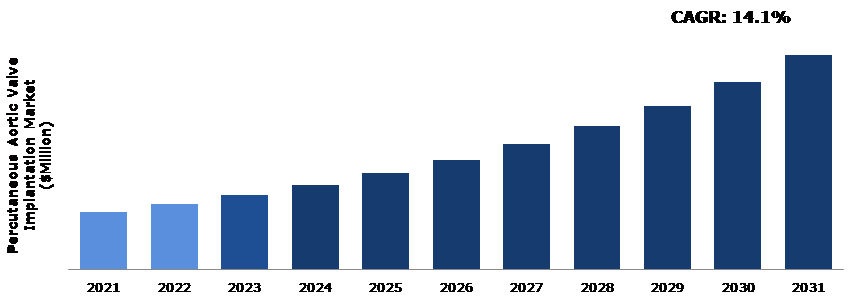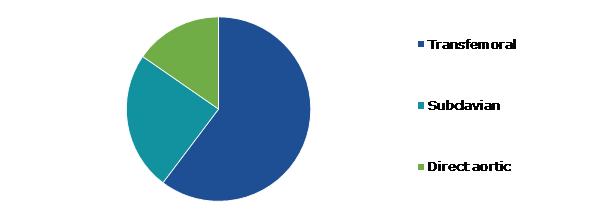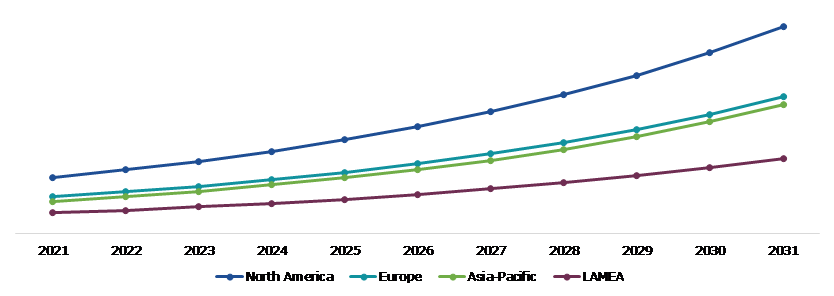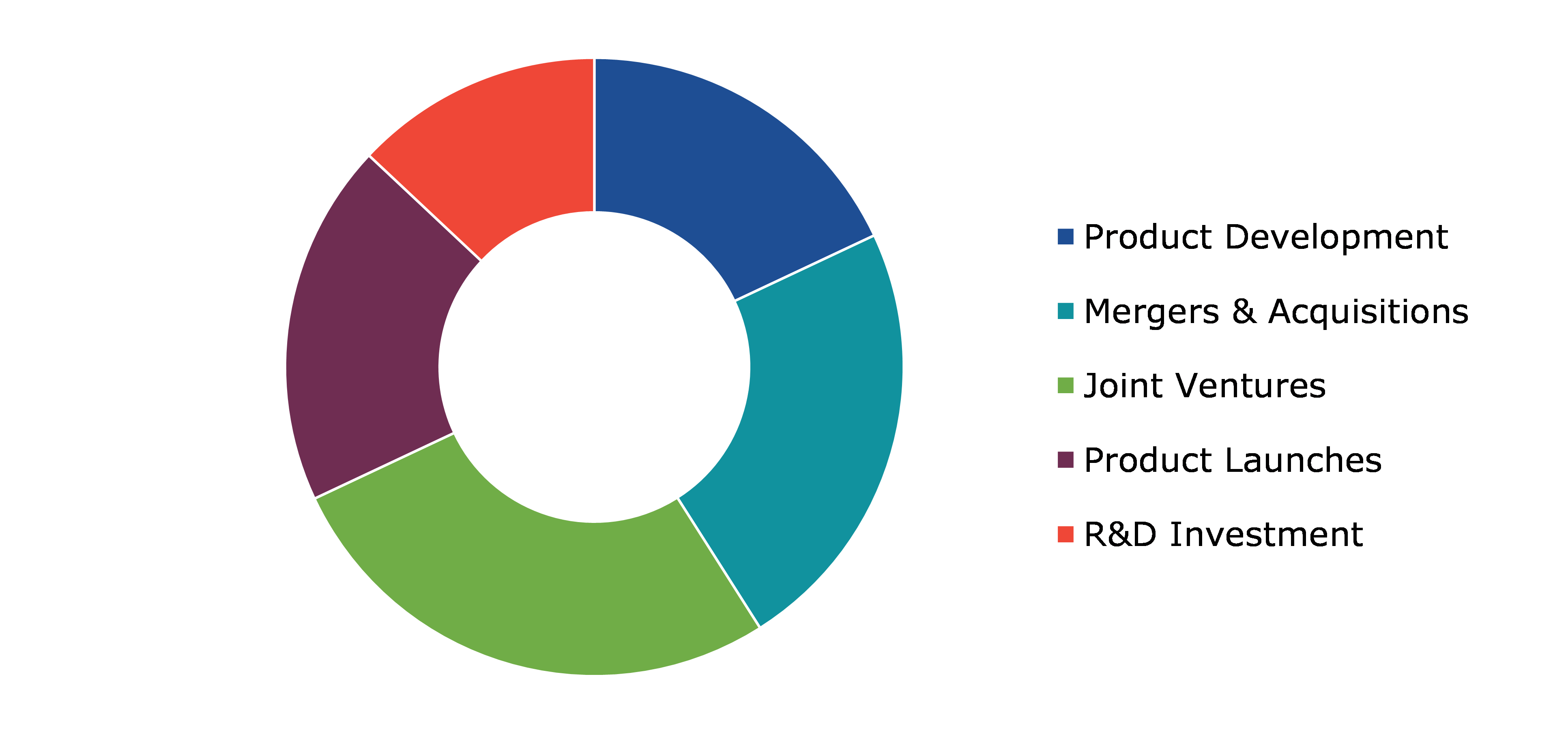Percutaneous Aortic Valve Implantation Market Report
RA08575
Percutaneous Aortic Valve Implantation Market by Procedure (Transfemoral, Subclavian, and Direct Aortic), End-User (Hospitals & Cardiac Centers and Ambulatory Surgical Center), and Regional Analysis (North America, Europe, Asia-Pacific, and LAMEA): Global Opportunity Analysis and Industry Forecast, 2022-2031
Global Percutaneous Aortic Valve Implantation Market Analysis
The Global Percutaneous Aortic Valve Implantation Market Size was $5,410.20 million in 2021 and is predicted to grow with a CAGR of 14.1%, by generating a revenue of $20,132.20 million by 2031.
Global Percutaneous Aortic Valve Implantation Market Synopsis
In high-risk patients with aortic stenosis, percutaneous aortic valve implantation is an emergent technique that can be used instead of surgical aortic valve replacement. Percutaneous aortic valve implantation techniques are rapidly evolving and represent a dynamic field of research.
The rising prevalence of cardiovascular diseases in the elderly population has improved surgical treatments, and the growing demand for surgical technologies is propelling the percutaneous aortic valve implantation (PAVR) market. Furthermore, healthcare investment has increased, which will aid the market's expansion. These are the factors that have contributed to the market's rapid growth over the forecast period. As a result, global demand for the market is expected to rise. Additionally, the market is being propelled by an increase in PAVI treatment acceptance, new device approvals, and more clinical evidence of success. All these factors boost the percutaneous aortic valve implantation market growth.
PAVI market growth is hampered by stringent government regulations for licensing class III medical devices such as transcatheter aortic valves, as well as the high cost of PAVI. Furthermore, the high cost of transcatheter heart valve devices in developing and underdeveloped countries has resulted in inadequate heart valve installation in healthcare facilities.
The growing preference for minimally invasive surgeries, as well as an increase in healthcare professionals in emerging markets, will drive the global percutaneous aortic valve implantation market. Furthermore, to grow in the market, companies involved in global percutaneous aortic valve implantation are employing effective strategies and launching innovative products. For example, Abbott Laboratories, a medical device company based in the U.S., announced in September 2021 that their products, such as the Portico with FlexNav transcatheter aortic valve replacement (TAVR) system, had been approved by the United States Food and Drug Administration (FDA); this system is designed to treat people with severe aortic stenosis who are at high risk of open-heart surgery. Such factors may also lead to lucrative market opportunities in the coming years.
According to regional analysis, the North America percutaneous aortic valve implantation market accounted for highest market share in 2021. The extensive growth of the North American percutaneous aortic valve implantation market is primarily driven by high disposable incomes, with the presence of top leading brands augmenting the region's industry growth.
Percutaneous Aortic Valve Implantation Overview
Percutaneous aortic valve replacement (PAVR) or transcatheter aortic valve replacement (TAVR) is a relatively recent treatment for aortic stenosis. A replacement valve is crimped into a catheter and inserted via the femoral artery to the aortic annulus during the procedure. Rapid ventricular pacing is used to reduce cardiac output while the prosthesis is deployed into the proper position following balloon valvuloplasty.
COVID-19 Impact on Global Percutaneous Aortic Valve Implantation Market
The novel coronavirus pandemic devastated several industries, including the percutaneous aortic valve implantation market, which experienced negative growth during this time period. Manufacturing capacity of percutaneous aortic valve implantation devices was affected due to global lockdown. In addition, most surgeries were postponed due to strict government regulations to perform only surgeries in emergency departments (ED). All of these factors contributed to the global percutaneous aortic valve implantation industry's revenue loss. Thus, the aforementioned factors indicate that the pandemic had an impact on global percutaneous aortic valve implantation.
As the proportion of COVID-19 cases decreased over time, the number of surgeries increased, allowing the transcatheter aortic valve implantation (TAVI) device market to recover. Despite the pandemic, the market's device manufacturers continue to launch new products. On September 28th, Boston Scientific announced that the Accurate neo2 aortic valve system was now available in Europe. Boston Scientific's ability to bring this device to European markets during the COVID-19 outbreak demonstrates the market's resilience. The number of TAVR surgeries was rapidly increasing prior to the pandemic, and this trend is unlikely to have slowed as a result of the COVID-19.
Increasing Incidence of Cardiovascular Disorders to Surge the Market Growth
The global percutaneous aortic valve implantation industry is expanding rapidly, owing primarily to an increasing population suffering from cardiovascular diseases. Furthermore, cardiovascular diseases impair aortic valve function, which can lead to heart attacks and necessitate valve replacement surgery.
Moreover, top players in the percutaneous aortic valve implantation market are implementing various strategies and innovations to stay ahead in the competitive environment, in addition to government approval of percutaneous aortic valve implantation. For example, in 2019, Boston Scientific Corp., a medical device manufacturing company based in the U.S., announced that their LOTUS Edge valve system had been approved by the FDA (Food and Drug Administration). This device is designed to provide relief to patients suffering from aortic stenosis. These types of initiatives drive the global percutaneous aortic valve implantation market.
To know more about global percutaneous aortic valve implantation market drivers, get in touch with our analysts here.
High Setup Cost of Percutaneous Aortic Valve Implantation to Restrain the Market Growth
One of the factors expected to restrain global market growth during the forecast period is the high setup cost of percutaneous aortic valve implantation devices. Furthermore, lack of awareness about the availability of percutaneous aortic valve implantation, particularly in developing countries, is one of the factors that may have a negative impact on market growth during the forecast period. In addition, strict regulation to restraint the approval of transcatheter devices to prevent surgical patient injury hamper the market growth.
Growing Prevalence of Minimally Invasive Therapies in the Market to Create Massive Investment Opportunities
The global percutaneous aortic valve implantation market is expanding rapidly as more people choose minimally invasive therapies for their surgeries. Patients are increasingly opting for minimally invasive procedures in order to receive efficient and effective therapy while also recovering quickly, which is propelling the growth of the percutaneous aortic valve implantation market. Furthermore, the growing elderly population will increase the demand for invasive surgeries, as open-heart surgeries are risky for the elderly. As a result, all of these factors contribute to market growth.
Furthermore, certain key vendors involved in percutaneous aortic valve implantation are implementing new strategies and innovations to stay ahead of the competition. For example, Abbott Laboratories, a medical device company, announced in April 2020 that their product, the TriClip Transcatheter Tricuspid Valve Repair System, had received CE Mark approval. This is a non-surgical system used in the treatment of percutaneous aortic valve implantation in humans. All of these factors could result in lucrative market opportunities for key players in the coming years.
To know more about global percutaneous aortic valve implantation market opportunities, get in touch with our analysts here.
Global Percutaneous Aortic Valve Implantation Market, by Procedure
Based on procedure, the market has been divided into transfemoral, subclavian, and direct aortic. Among these, the transfemoral sub-segment accounted for the highest market share in 2021 and is estimated to show the fastest growth during the forecast period.
Global Percutaneous Aortic Valve Implantation Market Size, by Procedure, 2021
Source: Research Dive Analysis
The transfemoral procedure accounted for a highest market share in 2021. The standardized TAVI procedure is transfemoral implantation, in which an artificial valve is implanted through the femoral artery with minimal anesthesia. However, because of their weak and small arteries, some patients are unable to undergo transfemoral TAVI. Transapical implantation, in which the artificial valve is inserted through the left ventricular apex, is preferred in this case. Furthermore, transaortic implantation is designed for patients with weak femoral arteries and poor respiratory function, making them ineligible for both transfemoral and transapical TAVI procedures.
Global Percutaneous Aortic Valve Implantation Market, by End-User
Based on end-user, the market has been divided into hospitals & cardiac centers, and ambulatory surgical center. Among these, the hospitals and cardiac centers sub-segment accounted for the highest revenue share in 2021.
Global Percutaneous Aortic Valve Implantation Market Share, by End-user, 2021
Source: Research Dive Analysis
The hospitals and cardiac centers sub-segment accounted for a highest market share in 2021. This market expansion can be attributed to an increasing number of patients who prefer hospitals and cardiac centers for their surgeries and treatments. The rapid growth of the sub-segment is attributed to improved hospital accessibility and expertise. Furthermore, hospitals and cardiac centers provide advanced devices as well as skilled doctors and workforce, which is expected to influence customers to seek treatment in hospitals and cardiac centers. All of these factors may increase demand for hospitals and cardiac centers, accelerating market growth.
Global Percutaneous Aortic Valve Implantation Market, Regional Insights
The percutaneous aortic valve implantation market was investigated across North America, Europe, Asia-Pacific, and LAMEA.
Global Percutaneous Aortic Valve Implantation Market Size & Forecast, by Region, 2021-2031 (USD Million)
Source: Research Dive Analysis
The Market for Percutaneous Aortic Valve Implantation in North America to be the Most Dominant
North America accounted for a highest market share in 2021. The extensive growth of the North American percutaneous aortic valve implantation market is primarily driven by high disposable incomes, with the presence of top leading brands augmenting the region's industry growth. Furthermore, the majority of people in North America suffer from cardiovascular diseases, which is fueling market growth across the region. Furthermore, according to the International Journal of Epidemiology, approximately 610,000 people in the U.S. suffered from heart disease in 2019, with 735,000 having a heart attack. These factors will ultimately drive demand in the region's percutaneous aortic valve implantation market.
This is due to the widespread use of technologically advanced products, mergers, and acquisitions as well as favorable reimbursement policies. For example, reimbursement from government agencies such as the Centers for Medicare & Medicaid Services (CMS) enables patients to choose transcatheter aortic valve replacement. In 2017, Medicare was the primary payer for nearly 90% of TAVR procedures. This increased the economic advantage of TAVR over surgical aortic valve replacement (SAVR).
Competitive Scenario in the Global Percutaneous Aortic Valve Implantation Market
Investment and agreement are common strategies followed by major market players. For instance, in February 2022, Baylis Medical Company Inc., a provider of advanced trans septal access solutions as well as dilators, sheaths, and guidewires for catheter-based left-heart procedures, was acquired by Boston Scientific Corporation. Boston Scientific will be able to integrate the Baylis platforms with its existing electrophysiology and structural heart offerings, further solidifying its position in the fastest-growing cardiology markets.
Source: Research Dive Analysis
Some of the leading percutaneous aortic valve implantation market players are Boston Scientific Corporation, Abbott Laboratories, Becton Dickinson and Company, Bracco, Edwards Lifesciences Corporation, JenaValve Technology, Inc., Venus Medtech, Medtronic Plc., Meril Lifesciences, and JC Medical Inc.
| Aspect | Particulars |
| Historical Market Estimations | 2020 |
| Base Year for Market Estimation | 2021 |
| Forecast Timeline for Market Projection | 2022-2031 |
| Geographical Scope | North America, Europe, Asia-Pacific, and LAMEA |
| Segmentation by Procedure |
|
| Segmentation by End-user |
|
| Key Companies Profiled |
|
Q1. What is the size of the global percutaneous aortic valve implantation market?
A. The size of the percutaneous aortic valve implantation market was over $5,410.20 million in 2021 and is projected to reach $20,132.20 million by 2031.
Q2. Which are the major companies in the percutaneous aortic valve implantation market?
A. Edwards Lifesciences Corporation and Abbott Laboratories are some of the key players in the global percutaneous aortic valve implantation market.
Q3. Which region, among others, possesses greater investment opportunities in the near future?
A. The Asia-Pacific region possesses great investment opportunities for investors to witness the most promising growth in the future.
Q4. What will be the growth rate of the Asia-Pacific percutaneous aortic valve implantation market?
A. Asia-Pacific percutaneous aortic valve implantation market is anticipated to grow at 14.7% CAGR during the forecast period.
Q5. What are the strategies opted by the leading players in this market?
A. Agreement and investment are the two key strategies opted by the operating companies in this market.
Q6. Which companies are investing more on R&D practices?
A. Edwards Lifesciences Corporation and Abbott Laboratories are investing more on R&D activities for developing new products and technologies.
1.Research Methodology
1.1.Desk Research
1.2.Real time insights and validation
1.3.Forecast model
1.4.Assumptions and forecast parameters
1.5.Market size estimation
1.5.1.Top-down approach
1.5.2.Bottom-up approach
2.Report Scope
2.1.Market definition
2.2.Key objectives of the study
2.3.Report overview
2.4.Market segmentation
2.5.Overview of the impact of COVID-19 on the percutaneous aortic valve implantation market
3.Executive Summary
4.Market Overview
4.1.Introduction
4.2.Growth impact forces
4.2.1.Drivers
4.2.2.Restraints
4.2.3.Opportunities
4.3.Market value chain analysis
4.3.1.List of raw material suppliers
4.3.2.List of manufacturers
4.3.3.List of distributors
4.4.Innovation & sustainability matrices
4.4.1.Technology matrix
4.4.2.Regulatory matrix
4.5.Porter’s five forces analysis
4.5.1.Bargaining power of suppliers
4.5.2.Bargaining power of consumers
4.5.3.Threat of substitutes
4.5.4.Threat of new entrants
4.5.5.Competitive rivalry intensity
4.6.PESTLE analysis
4.6.1.Political
4.6.2.Economical
4.6.3.Social
4.6.4.Technological
4.6.5.Environmental
4.7.Impact of COVID-19 on the percutaneous aortic valve implantation market
4.7.1.Pre-covid market scenario
4.7.2.Post-covid market scenario
5.Percutaneous Aortic Valve Implantation Market Analysis, by Procedure
5.1.Overview
5.2.Transfemoral
5.2.1.Definition, key trends, growth factors, and opportunities
5.2.2.Market size analysis, by region, 2021-2031
5.2.3.Market share analysis, by country, 2021-2031
5.3.Subclavian
5.3.1.Definition, key trends, growth factors, and opportunities
5.3.2.Market size analysis, by region, 2021-2031
5.3.3.Market share analysis, by country, 2021-2031
5.4.Direct aortic
5.4.1.Definition, key trends, growth factors, and opportunities
5.4.2.Market size analysis, by region, 2021-2031
5.4.3.Market share analysis, by country, 2021-2031
5.5.Research Dive Exclusive Insights
5.5.1.Market attractiveness
5.5.2.Competition heatmap
6.Percutaneous Aortic Valve Implantation Market Analysis, by End-user
6.1.Hospitals and Cardiac Centers
6.1.1.Definition, key trends, growth factors, and opportunities
6.1.2.Market size analysis, by region, 2021-2031
6.1.3.Market share analysis, by country, 2021-2031
6.2.Ambulatory Surgical Center
6.2.1.Definition, key trends, growth factors, and opportunities
6.2.2.Market size analysis, by region, 2021-2031
6.2.3.Market share analysis, by country, 2021-2031
6.3.Research Dive Exclusive Insights
6.3.1.Market attractiveness
6.3.2.Competition heatmap
7.Percutaneous Aortic Valve Implantation Market, by Region
7.1.North America
7.1.1.U.S.
7.1.1.1.Market size analysis, by Procedure, 2021-2031
7.1.1.2.Market size analysis, by End-user, 2021-2031
7.1.2.Canada
7.1.2.1.Market size analysis, by Procedure, 2021-2031
7.1.2.2.Market size analysis, by End-user, 2021-2031
7.1.3.Mexico
7.1.3.1.Market size analysis, by Procedure, 2021-2031
7.1.3.2.Market size analysis, by End-user, 2021-2031
7.1.4.Research Dive Exclusive Insights
7.1.4.1.Market attractiveness
7.1.4.2.Competition heatmap
7.2.Europe
7.2.1.Germany
7.2.1.1.Market size analysis, by Procedure, 2021-2031
7.2.1.2.Market size analysis, by End-user, 2021-2031
7.2.2.UK
7.2.2.1.Market size analysis, by Procedure, 2021-2031
7.2.2.2.Market size analysis, by End-user, 2021-2031
7.2.3.France
7.2.3.1.Market size analysis, by Procedure, 2021-2031
7.2.3.2.Market size analysis, by End-user, 2021-2031
7.2.4.Spain
7.2.4.1.Market size analysis, by Procedure, 2021-2031
7.2.4.2.Market size analysis, by End-user, 2021-2031
7.2.5.Italy
7.2.5.1.Market size analysis, by Procedure, 2021-2031
7.2.5.2.Market size analysis, by End-user, 2021-2031
7.2.6.Rest of Europe
7.2.6.1.Market size analysis, by Procedure, 2021-2031
7.2.6.2.Market size analysis, by End-user, 2021-2031
7.2.7.Research Dive Exclusive Insights
7.2.7.1.Market attractiveness
7.2.7.2.Competition heatmap
7.3.Asia-Pacific
7.3.1.China
7.3.1.1.Market size analysis, by Procedure, 2021-2031
7.3.1.2.Market size analysis, by End-user, 2021-2031
7.3.2.Japan
7.3.2.1.Market size analysis, by Procedure, 2021-2031
7.3.2.2.Market size analysis, by End-user, 2021-2031
7.3.3.India
7.3.3.1.Market size analysis, by Procedure, 2021-2031
7.3.3.2.Market size analysis, by End-user, 2021-2031
7.3.4.Australia
7.3.4.1.Market size analysis, by Procedure, 2021-2031
7.3.4.2.Market size analysis, by End-user, 2021-2031
7.3.5.South Korea
7.3.5.1.Market size analysis, by Procedure, 2021-2031
7.3.5.2.Market size analysis, by End-user, 2021-2031
7.3.6.Rest of Asia-Pacific
7.3.6.1.Market size analysis, by Procedure, 2021-2031
7.3.6.2.Market size analysis, by End-user, 2021-2031
7.3.7.Research Dive Exclusive Insights
7.3.7.1.Market attractiveness
7.3.7.2.Competition heatmap
7.4.LAMEA
7.4.1.Brazil
7.4.1.1.Market size analysis, by Procedure, 2021-2031
7.4.1.2.Market size analysis, by End-user, 2021-2031
7.4.2.Saudi Arabia
7.4.2.1.Market size analysis, by Procedure, 2021-2031
7.4.2.2.Market size analysis, by End-user, 2021-2031
7.4.3.UAE
7.4.3.1.Market size analysis, by Procedure, 2021-2031
7.4.3.2.Market size analysis, by End-user, 2021-2031
7.4.4.South Africa
7.4.4.1.Market size analysis, by Procedure, 2021-2031
7.4.4.2.Market size analysis, by End-user, 2021-2031
7.4.5.Rest of LAMEA
7.4.5.1.Market size analysis, by Procedure, 2021-2031
7.4.5.2.Market size analysis, by End-user, 2021-2031
7.4.6.Research Dive Exclusive Insights
7.4.6.1.Market attractiveness
7.4.6.2.Competition heatmap
8.Competitive Landscape
8.1.Top winning strategies, 2021
8.1.1.By strategy
8.1.2.By year
8.2.Strategic overview
8.3.Market share analysis, 2021
9.Company Profiles
9.1.Boston Scientific Corporation
9.1.1.Overview
9.1.2.Business segments
9.1.3.Product portfolio
9.1.4.Financial performance
9.1.5.Recent developments
9.1.6.SWOT analysis
9.2.Abbott Laboratories
9.2.1.Overview
9.2.2.Business segments
9.2.3.Product portfolio
9.2.4.Financial performance
9.2.5.Recent developments
9.2.6.SWOT analysis
9.3.Becton Dickinson and Company
9.3.1.Overview
9.3.2.Business segments
9.3.3.Product portfolio
9.3.4.Financial performance
9.3.5.Recent developments
9.3.6.SWOT analysis
9.4.Bracco
9.4.1.Overview
9.4.2.Business segments
9.4.3.Product portfolio
9.4.4.Financial performance
9.4.5.Recent developments
9.4.6.SWOT analysis
9.5.Edwards Lifesciences Corporation
9.5.1.Overview
9.5.2.Business segments
9.5.3.Product portfolio
9.5.4.Financial performance
9.5.5.Recent developments
9.5.6.SWOT analysis
9.6.JenaValve Technology, Inc.
9.6.1.Overview
9.6.2.Business segments
9.6.3.Product portfolio
9.6.4.Financial performance
9.6.5.Recent developments
9.6.6.SWOT analysis
9.7.Venus Medtech
9.7.1.Overview
9.7.2.Business segments
9.7.3.Product portfolio
9.7.4.Financial performance
9.7.5.Recent developments
9.7.6.SWOT analysis
9.8.Medtronic Plc.
9.8.1.Overview
9.8.2.Business segments
9.8.3.Product portfolio
9.8.4.Financial performance
9.8.5.Recent developments
9.8.6.SWOT analysis
9.9.Meril Lifesciences
9.9.1.Overview
9.9.2.Business segments
9.9.3.Product portfolio
9.9.4.Financial performance
9.9.5.Recent developments
9.9.6.SWOT analysis
9.10.JC Medical Inc.
9.10.1.Overview
9.10.2.Business segments
9.10.3.Product portfolio
9.10.4.Financial performance
9.10.5.Recent developments
9.10.6.SWOT analysis
Percutaneous aortic valve replacement (PAVR) or transcatheter aortic valve replacement (TAVR) is a relatively new method for treating aortic stenosis, however, it has become increasingly common over the past few years. During the PAVR procedure, a replacement valve is crimped onto a catheter and inserted through the femoral artery into the aortic annulus. Quick ventricular pacing is utilized to minimize cardiac output while the prosthesis is placed in the right position following balloon valvuloplasty.
The global percutaneous aortic valve implantation market is growing quickly, mostly due to the rising prevalence of cardiovascular disorders. Cardiovascular disorders impede aortic valve function, resulting in heart attacks and the need for valve replacement surgery. In addition, the increasing number of geriatric patients is propelling the demand for PAVR treatment, as older people are more susceptible to aortic stenosis. The global percutaneous aortic valve implantation market is quickly rising as more patients prefer minimally invasive procedures in their surgeries. All these factors are expanding the growth of the global percutaneous aortic valve implantation market at a rapid pace.
Newest Insights in the Percutaneous Aortic Valve Implantation Market
PAVR is becoming more popular as a result of the rising technological advancements in the PAVR valve. As per a report by Research Dive, the global percutaneous aortic valve implantation market is anticipated to surpass a revenue of $20,132.20 million in the 2022–2031 timeframe. The North America percutaneous aortic valve implantation market is predicted to experience dominant growth in the years to come. This is because of high disposable incomes due to the existence of leading brands enhancing the region's industrial growth and rising number of people suffering from heart disorders in the region.
How are Market Players Responding to the Rising Demand for PAVI?
Market players are greatly investing in pioneering research and inventions, collaborating with other market players, and receiving government permissions for implementing percutaneous aortic valve implantation, to maintain a competitive environment. Some of the foremost players in the percutaneous aortic valve implantation market are Abbott Laboratories, Becton Dickinson and Company, Boston Scientific Corporation, Bracco, JenaValve Technology, Inc., Edwards Lifesciences Corporation, Venus Medtech, Meril Lifesciences, JC Medical Inc., Medtronic Plc., and others. These players are focused on implementing strategies such as mergers and acquisitions, novel developments, collaborations, and partnerships to reach a leading position in the global market. For instance:
- In September 2022, Edwards Lifesciences, an international leader in structural heart disease medical innovation, announced the introduction of the SAPIEN 3 Ultra RESILIA valve, which combines Edwards’ ground-breaking RESILIA tissue technology with the top SAPIEN 3 Ultra transcatheter aortic heart valve.
- In October 2022, OpSens , a well-known expert and innovator in the field of optical measurement for medical equipment, announced that the SavvyWire, a novel guidewire for TAVR surgeries, acquired 510(k) regulatory clearance from the U.S. FDA (Food & Drug Administration).
- In December 2022, Abbott, a global healthcare company, launched a minimally invasive device available for persons in India with arterial disease insufficiency who are at high or extreme surgical risk. The system is called Navitor. It is the most recent TAVI system of the company.
COVID-19 Impact on the Global Percutaneous Aortic Valve Implantation Market
The unpredicted rise of the coronavirus pandemic in 2020 adversely impacted the global percutaneous aortic valve implantation market. During the pandemic period, the global shutdown had an effect on the capacity to manufacture percutaneous aortic valve implantation devices. In addition, most operations were delayed due to strict government laws requiring only emergency departments (ED) to undertake surgeries. All of these factors contributed to the revenue loss in the global percutaneous aortic valve implantation market. However, TAVI device sales recovered as the percentage of COVID-19 cases declined over time and more procedures were conducted. Hence, the market is expected to observe massive growth in the years to come.
Personalize this research
- Triangulate with your own data
- Request your format and definition
- Get a deeper dive on a specific application, geography, customer or competitor
- + 1-888-961-4454 Toll - Free
- support@researchdive.com






